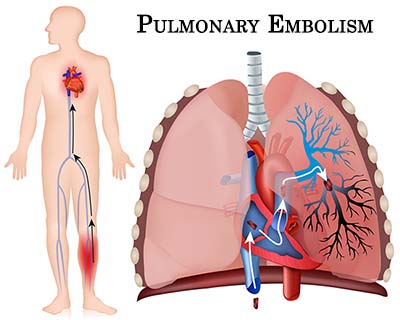
What is pulmonary embolism?
The human body consists of intricate pipes that carry blood around its organs. The flow of the blood can sometimes be impeded by a clot formed in this vascular system, leading to blockage of blood supply to the organs. When the blockage occurs at the lungs, it is called pulmonary embolism.
Hence, pulmonary embolism is when a blood clot (thrombus) becomes lodged in an artery in the lung and blocks blood flow to the lung. In a simple term pulmonary (lungs), embolism (clot) is a clot in the lung.
The lung is an organ that helps in the exchange of gases in the body. Air enters through the nostrils into the lung tissues where oxygen is exchanged for carbon dioxide. The oxygen is carried to the tissues to burn food and give energy.
Pulmonary thromboembolism is not a disease in and of itself. Rather, it is a complication of underlying clots in the veins. Under normal conditions, microthrombi (tiny aggregates of red cells, platelets, and fibrin) are formed and lysed continually within the venous circulatory system. Usually, there are illnesses that predispose to this condition. While PE itself can not be classified as a terminal disease, some terminal illnesses like cancers or HIV can lead to it.
A disease that will result ultimately into death and whose treatment is usually palliative.
· What do medical people mean by “Terminal”
Terminal illness or end-stage disease is a disease thatcan nott be cured or adequately treated and is expected to result in the death of the patient. This term is more commonly used for progressive diseases such as cancer, dementia or advanced heart disease than for injury.
· Can PE be said to be related to high blood pressure?
PE is shown to be related to hypertension in three main ways:
1. High blood pressure damages the walls of your arteries. The damage makes those arteries more likely to develop deposits of plaque that harden, narrow or block your arteries. These deposits also can lead to blood clots. Blood clots can flow through your bloodstream and block blood flow to the lungs, heart or brain, resulting in a pulmonary embolism, heart attack, or stroke.
2. Pulmonary embolism also can lead to pulmonary hypertension, a condition in which the blood pressure in the lungs and in the right side of the heart is too high. When you have blockages in the arteries inside your lungs, your heart must work harder to push blood through those vessels. PE can thus worsens systemic hypertension.
3. There are common preconditions to hypertension and pulmonary embolism. Conditions like smoking, obesity, sedentary life styles, diabetes can cause both hypertension and PE.
· What are its causes?
The most common cause of a pulmonary embolism is the breaking off of a blood clot in the leg’s deep veins, known as deep vein thrombosis (DVT).
Other, rare causes of a pulmonary embolism include: Air bubbles. DVT in the upper body. Blood usually pools after long periods of inactivity, such as after surgery or bed rest. Injury to a vein, such as from a fracture or surgery (especially in your pelvis, hip, knee or leg).
Broadly causes of pulmonary embolism are multifactorial and classified into:
· Venous stasis
· Hypercoagulable states
· Immobilization
· Surgery and trauma
· Pregnancy
· Oral contraceptives and estrogen replacement
· Malignancy
· Hereditary factors
· Acute medical illness
Let me explain some terms further.
Venous stasis means stagnation of blood flows in the veins. We sit down a lot, some people are in prolonged admission or bedridden, lack of exercise etc can lead to such stagnation.
Hypercoagulation state is the situation where the blood is thick and flow slowed down. In some cases of cancer of the blood, we see excess production of blood cells leading to formation of clots easily inside the arteries.
· Does it affect Blacks more than Whites?
The incidence of pulmonary embolism appears to be significantly higher in blacks than in whites.
Mortality rates from pulmonary embolism for blacks have been 50% higher than those for whites, and those for whites have been 50% higher than those for people of other races Asians, Native Americans.
Inequality of access to health could be a factor.
· Is it common in male more than females?
Data are conflicting as to whether male sex is a risk factor for pulmonary embolism; however, studies found that death rates from pulmonary embolism were 20-30% higher among men than among women.
For example, a prospective cohort study of female nurses found an association between idiopathic pulmonary embolism and hours spent sitting each week.
We should beware of prolonged sitting.
It has become more popular after COVID-19. Does it have anything to do with the viral disease?
Risk of DVT, bleeding events and pulmonary embolism are higher during and up to six months after Covid 19 infection.
Findings suggest that covid-19 is a risk factor for deep vein thrombosis, pulmonary embolism, and bleeding.
Why? Some people infected with SARS-CoV-2 develop abnormal blood clotting. “In some people with COVID-19, we’re seeing a massive inflammatory response, the cytokine storm that raises clotting factors in the blood.
During the epidemics of Coronavirus, we witnessed more blood clots in the lungs (pulmonary embolism), legs (deep vein thrombosis).
Right now, we are still understudying the Post Covid 19 Syndrome which includes a lot of complications
· What are the signs to look out for in the body that could suggest that one is battling this condition?
One may not have any symptoms of a pulmonary embolism, depending on the size of the clot and your overall health. PE is often difficult to diagnose because the signs and symptoms of PE are a lot like those of many other conditions and diseases.
As blood flow becomes more and more blocked, you may experience symptoms such as:
· Coughing, including a cough that produces bloody mucus.
· Dizziness, Heart palpitations, sensations of your heart racing or pounding, Leg pain or swelling, Sharp and sudden chest pain,
· Shortness of breath that worsens with exertion.
· Sudden shortness of breath is the most common symptom of a PE.
The followings are common.
· Difficulty in breathing
· Chest pain
· Cough
· Coughing of blood
Just for the records, can PE be resolved through drinking of alcohol or herbal concoction?
This is a tricky one. Alcohol in low or moderate consumption may lower clothing risk. But there are other problems associated with alcohol consumption.
I will therefore not recommend alcohol consumption for a PE patient.
As for herbal drugs, I am not competent to comment on that. But we know some fruits and vegetables can help blood flow e.g. onions
What are the tips for someone to prevent pulmonary embolism?
The best way to prevent a pulmonary embolism is to try and stop blood clots forming in your veins.
We can all reduce our risk of blood clotting by changing our habits to lead a healthier lifestyle:
· Stopping smoking – if you smoke, quitting is the best thing you can do for your health.
· Getting regular exercise
· Not sitting still for a long time – such as when watching TV or using a computer.
· Avoid becoming dehydrated.
· Maintaining a healthy weight, by eating a healthy balanced diet.
· Do a health check-up regularly to know your risk of PE, heart attack and stroke.
Finally, what is the medical treatment for those already affected by it?
Once a diagnosis of PE is made, it thus requires a serious medical attention.
Big clots in the lungs will require admission into intensive care and procedure remove the clots.
After which blood thinning drugs will be prescribed.
People with high risks are placed on antiplatelets or blood thinners while close monitoring is done.
*Culled from PLATFORMS AFRICA














